
* In the 1950s, the British Royal Air Force (RAF) introduced the service's first purpose-built jet trainer, the "Percival Jet Provost", which was made in some numbers and served for decades. A light strike derivative, the "Strikemaster", also proved its value. This document provides a history and description of the Jet Provost / Strikemaster, as well as its piston-powered "Provost" predecessor, and other related trainers: Fokker S-14, CAC Winjeel, and HAL Kiran. A list of illustration credits is included at the end.

* The earliest jet trainers were variants of early jet fighters -- such as the trainer versions of the British Gloster Meteor, and the Lockheed T-33 trainer, based on the F-80 Shooting Star. The first, or at least one of the first, purpose-designed jet trainers to go into service was developed and built by Fokker of the Netherlands, in the form of the "S.14 Machtrainer".
Development of the S.14 was initiated in the late 1940s by British aircraft engine manufacturer Rolls-Royce, which was promoting its "Derwent" engine -- a "centrifugal-flow" turbojet, using a fan stage with fans that looked like pump impellers. Fokker officials thought a trainer using the Derwent was a good idea, and managed to get an order for 20 aircraft from the Royal Netherlands Air Force (RNLAF).
The Machtrainer prototype performed its initial flight on 18 May 1951, with test pilot Gerben Sonderman at the controls. The prototype was powered by a Derwent V engine, with 15.6 kN (1,540 kgp / 3,500 lbf) thrust. The initial flight ended badly when the landing gear failed to extend and the aircraft had to land on its belly; it was repaired and returned to flight. Service machines featured a reinforced airframe, and a more powerful Derwent VIII engine, with 16 kN (1,630 kgp / 3,600 lbf) thrust. Deliveries of the Machtrainer were from 1955.
The S.14 was of all-metal construction. It was a "flying stovepipe" design, with a bifurcated engine inlet in the nose -- the airflow being split through ducts running around the sides of the cockpit -- and the jet exhaust in the extreme tail. It had tricycle landing gear, all with single wheels, the nose gear retracting forward, the main gear retracting inward from the wings. The landing gear was pneumatically actuated.
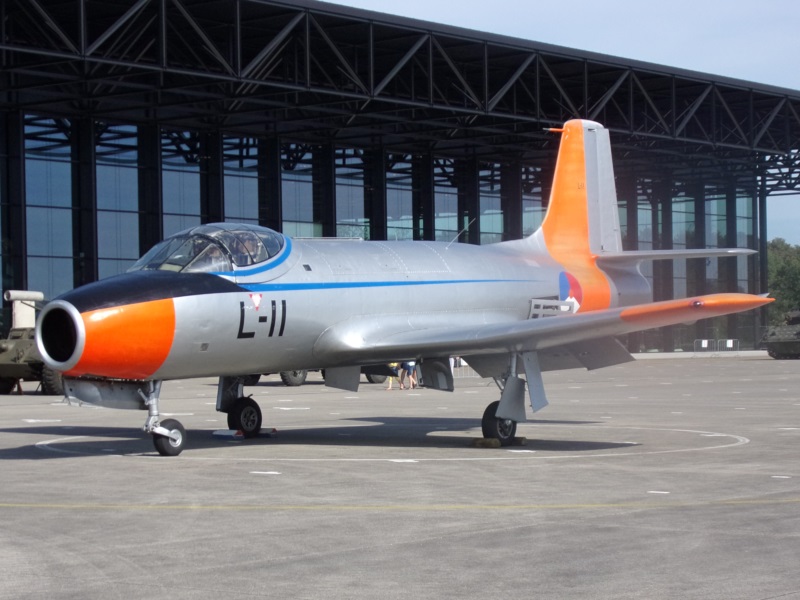
The S.14 had a conventional flight surface layout: low-mounted wing, tailplane above the exhaust, with the tailfin set forward from the exhaust. Flight control surfaces were also ordinary, including ailerons, flaps, rudder, elevators, and trim tabs, all with manual actuation. In addition, there were three dive brakes on the rear fuselage, with pneumatic actuation. The flight cadet and instructor sat side-by-side, on Martin-Baker ejection seats, under a "greenhouse"-style framed canopy that slid back to open.
___________________________________________________________________
FOKKER S.14 MACHTRAINER:
___________________________________________________________________
wingspan:
12 meters (39 feet 4 inch)
wing area:
13.8 sq_meters (342 sq_feet)
length:
13.3 meters (43 feet 8 inches)
height:
4.7 meters (15 feet 5 inches)
empty weight:
3,765 kilograms (8,300 pounds)
operating weight:
5,350 kilograms (11,795 pounds)
max speed:
750 KPH (450 MPH / 390 KT)
cruise speed:
590 KPH (365 MPH / 320 KT)
service ceiling:
11,500 meters (37,700 feet)
range:
950 kilometers (590 MI / 510 NMI)
___________________________________________________________________
The prototype was re-engined with a more powerful Nene III centrifugal-flow engine with 22.7 kN (2,310 kgp / 5,100 lbf) thrust-- the Derwent V/VIII was a scaled-down Nene -- as part of a proposed license manufacturing deal with Brazil, which went nowhere. A license deal with Fairchild of the USA similarly fell through, the US preferring the T-33, though the Machtrainer was evaluated by well-known test pilot Chuck Yeager while the aircraft was on a tour of the USA. There was consideration of an armed version, with a belly pack carrying twin 20-millimeter cannon, and a gunsight in the cockpit.
The S.14 was seen as too docile to be a good fighter trainer, so it was generally used as a proficiency trainer for older RNLAF officers -- giving it something of a reputation as an old folk's ride. The type was finally retired in 1967, with a handful, including the initial prototype, put on museum display.
BACK_TO_TOP* The road to the first British purpose-designed jet trainer was indirect. It began with British Air Ministry specification T.16/48, issued in September 1948, calling for a single-engine piston basic trainer for the Royal Air Force (RAF). The Percival company, which had supplied the Prentice trainer, then in service with the RAF, was among those that submitted proposals. -- their design largely being the work of a Polish-born aeronautical engineer named Henry Millicer.
Two finalists were selected from the proposals, including the Percival P.56 and the Handley-Page HPR.2, with two prototypes to be obtained for both. The two Percival prototypes, designated "Mark I", were to be powered by the Armstrong Siddeley Cheetah 7-cylinder air-cooled radial -- with Percival also building a third prototype, with the Alvis Leonides Mark 25 9-cylinder radial and designated "Mark 2". The initial Percival prototype, with the Cheetah engine, performed its initial flight on 24 February 1950. RAF evaluation followed, with the Leonides-powered P.56 variant selected for production, an initial order for 200 aircraft being placed in May 1951. The "Provost T1" entering service with the RAF in 1953.
The Provost was an all-metal aircraft, with an Alvis Leonides Mark 126 engine driving a three-bladed variable-pitch prop, a low-mounted wing, conventional tail arrangement, fixed taildragger landing gear with pneumatic brakes, and a side-by-side cockpit with a rear-sliding canopy. It was possible to fit a third seat, but apparently that was rarely done. All flight surfaces were tapered, with the tailplane set back relative to the tailfin; flight control surfaces were conventional, including flaps, ailerons, elevator, rudder, and trim tabs. Except for pneumatic flaps, all flight control surfaces were manually actuated. The canopy slid back to open.
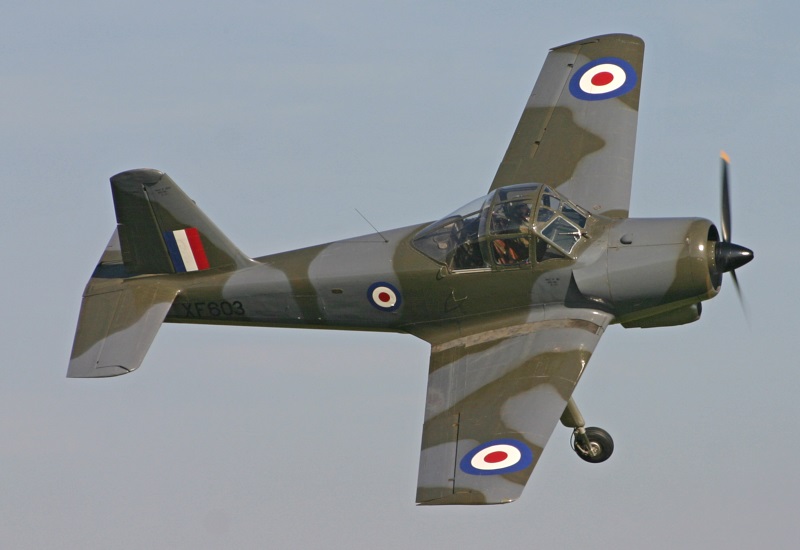
The Provost turned out to be pleasant to fly, light on the controls, proving a fair aerobatic aircraft, and with benign stall characteristics. Although RAF Provosts were unarmed, the type could be fitted with two 7.9-millimeter machine guns -- one in each wing, outboard of the main -- and carry three "60-pounder" rocket projectiles (RP) under each wing, for a total of six. Alternative external loads would be a 125-kilogram (250-pound) bomb under each wing, or various configurations of 12-kilogram (25-pound) bombs and RPs, for weapons training.
___________________________________________________________________
PERCIVAL PROVOST
___________________________________________________________________
wingspan:
10.67 meters (35 feet)
wing area:
19.9 sq_meters (214 sq_feet)
length:
8.69 meters (28 feet 6 inches)
height:
3.66 meters (12 feet)
empty weight:
1,520 kilograms (3,350 pounds)
operating weight:
1,995 kilograms (4,400 pounds)
max speed:
320 KPH (200 MPH / 170 KT)
service ceiling:
7,600 meters (25,000 feet)
range:
1,050 kilometers (650 MI / 560 NMI)
___________________________________________________________________
The last RAF production machine was delivered in 1956. There were a number of export sales, unarmed export trainers being designated "Provost T.51", with armed export machines being designated "T.52" or "T.53". Users included Burma, Iraq, Ireland, Malaysia, Oman, Rhodesia, and Sudan. Exact quantities are hard to determine, in particular because there was some horse-trading of used machines.
A total of 461 Provosts was built, 100 of them for export. The Provost was finally retired from RAF service in 1969, but endured in service elsewhere for much longer. A few are still flying on the warbird circuit.
* The Commonwealth Aircraft Corporation (CAC) of Australia built a near-clone of the Provost, named the "CA-25 Winjeel (Young Eagle)", built in response to Royal Australian Air Force (RAAF) Technical Requirement #AC.77, issued in 1948 and requesting a new basic trainer design to replace the CAC Wirraway (a license-built North American Texan) and the De Havilland Moth. Two prototypes flew in early 1951. They proved very stable -- too much so to be good trainers, with the tailfin moved forward to make them easier to spin. Aircraft were delivered to the RAAF from 1955, with the last of 62 production machines turned out in 1957.
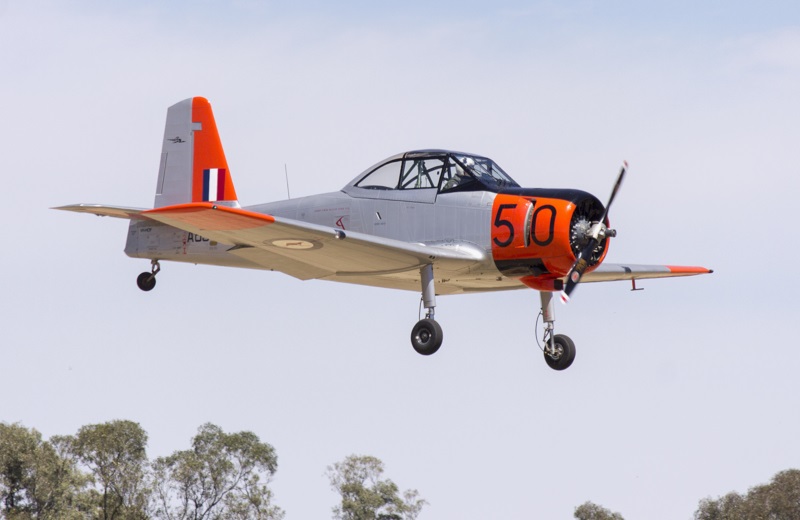
The Winjeel looked so much like a Provost that they could be easily mistaken for each other -- though the detail differences were significant enough to make them easily distinguished if placed side by side. The basic configuration was the same: low-wing all-metal aircraft with conventional flight control surfaces and fixed tricycle landing gear, side-by-side cockpit with rear-sliding canopy (plus room for a third seat if wanted), and radial engine -- in the Winjeel's case, a Pratt & Whitney R-985-AN-2 9-cylinder air-cooled Wasp Junior radial, with 330 kW (445 kW). The one obvious distinction between the Winjeel and the Provost was that the Winjeel had a two-bladed, variable-pitch prop, instead of the Provost's three-bladed prop. A less obvious distinction was that the Winjeel's mainwheels faced in, while the Provost's faced out.
___________________________________________________________________
CAC WINJEEL
___________________________________________________________________
wingspan:
11.8 meters (38 feet 8 inches)
wing area:
23.1 sq_meters (249 sq_feet)
length:
8.55 meters (28 feet)
height:
2.77 meters (9 feet 1 inch)
empty weight:
1,490 kilograms (3,290 pounds)
MTO weight:
600 kilograms (1,320 pounds)
max speed:
300 KPH (185 MPH / 160 KT)
cruise speed:
265 KPH (165 MPH / 145 KT)
service ceiling:
5,500 meters (18,000 feet)
endurance:
3.5 hours
___________________________________________________________________
No Winjeels were exported. They served in the ab initio / basic flight training role with the RAAF, when they were (supposedly) retired in favor of the Macchi MB-326 jet trainer -- the idea being that a jet could be used for both basic and advanced flight training. That proved untrue, so the Winjeel persisted in the basic flight training role until 1975, when it was replaced by the New Zealand-built PAC CT/4A Airtrainer. A handful of Winjeels were used for target marking, dropping smoke bombs, being retained in that role until 1994. A number of Winjeels are still flying.
BACK_TO_TOP* Having developed the Provost, in 1951 the Percival Company began work on a turbojet-powered successor. At the time, the RAF used the Provost for ab initio flight training, with the side-by-side seating de Havilland Vampire T.11 being obtained for jet training. Percival engineers thought it better to obtain a jet aircraft for both ab initio and jet training. The effort was company-funded, with the first prototype of the "Jet Provost" taking to the air, with company test pilot Dick Wheldon at the controls, on 26 June 1954 -- the same year in which Percival Aircraft became Hunting Percival. It was powered by an Armstrong-Siddeley (later Rolls-Royce) Viper 5 / Mark 101 small turbojet with 7.3 kN (745 kgp / 1,640 lbf) thrust.
The RAF was casting about for a jet trainer, and accordingly ordered a batch of "Jet Provost T.1" machines for development and evaluation. Ultimately, the RAF would obtain ten, Percival Hunting -- as the company had been renamed in 1954 -- building two for its own use.
Testing and evaluation revealed a need for some small changes, such as shorter landing gear to handle rougher fields; cleaning up fuselage aerodynamics; hydraulic systems substituted for pneumatic systems; and the addition of a dorsal fillet. The result was the "Provost T.2", with initial flight on 1 September 1955; four were built, strictly for test and evaluation. They were also used for international sales tours. One was passed on to Australia for evaluation, to be retained for trials there, while another -- a "T.2B", with a Viper 11 / Mark 200 engine providing 11.1 kN (1,135 kgp / 2,500 lbf) thrust -- was evaluated by Portugal.
In 1957 -- when Hunting Percival became simply Hunting Aircraft -- the RAF ordered an initial batch of the full-development "Provost T.3", with the first performing its initial flight on 22 June 1958. Following construction of a ground-test airframe, 201 T.3s were delivered to the RAF from 1958 to 1962.
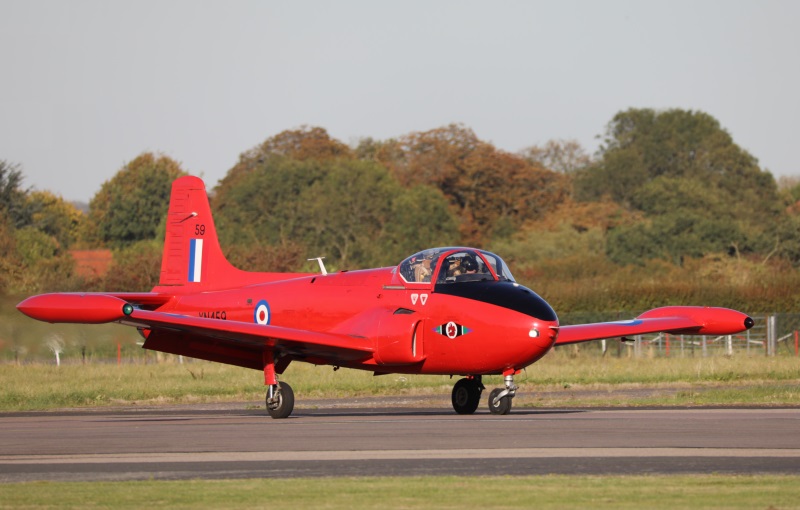
The Jet Provost T.3 derived its wings and tail surfaces from the original Provost, and had a similar side-by-side cockpit; but the fuselage was largely new. It was a low-wing aircraft of all-metal construction and conventional flight surface arrangement, with retractable tricycle landing gear -- all gear assemblies with single wheels, the nosewheel retracting backward, the main gear hinging in the wings in towards the fuselage. The landing gear was hydraulically actuated.
The T.3 was powered by a Viper 8 / Mark 102 turbojet, with 7.78 kN (795 kgp / 1,750 lbf) thrust, with electrical starting. All fuel storage was in the wings in bag tanks; tanks could be attached to the wingtips. All flight control surfaces were manually actuated, using a pushrod scheme, except for hydraulically-actuated flaps. There were also hydraulically-actuated air brakes. The T.3 was unpressurized, with the crew dependent on oxygen masks; they sat on lightweight Martin-Baker ejection seats; the T.1 and T.2 hadn't had ejection seats. The airframe was stronger than that of the original Provost, in particular having a reinforced wing spar. The Jet Provost was easy to maintain, having dozens of access panels, and a hinge-up nose. 70 T.3s were fitted with a VOR-DME navigation system receiver, to be redesignated "T.3A".
The "Jet Provost T.4" was generally similar to the T.3, but was fitted with a more powerful Viper 202 turbojet providing 11.1 kN (1,135 kgp / 2,500 lbf) thrust. 185 were built. One T.4 was fitted up with a Viper 522 engine as a private venture, to be known as the "BAC 166".
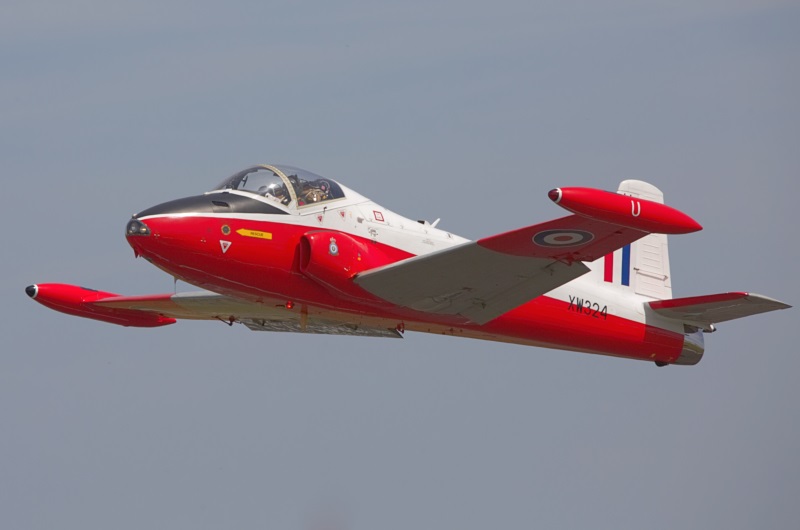
The definitive "Provost T.5" followed the T.4 in 1967, this variant being substantially redesigned -- with a longer nose for more avionics, a pressurized cockpit, a larger bubble-type canopy that slid back to open, stronger wings, more fuel capacity, and more external load capability. Wingtip tanks could be, but generally were not, fitted. 110 T.5s were built, with 93 converted to "T.5A" standard, featuring a VOR-DME receiver and a rough gray coating on the wings to improve stall warning; and 13 converted to "T.5B" standard (an informal designation), with wingtip tanks, intended for navigator training.
___________________________________________________________________
PERCIVAL JET PROVOST T.5
___________________________________________________________________
wingspan:
10.77 meters (35 feet 4 inches)
wing area:
19.85 sq_meters (214 sq_feet)
length:
10.36 meters (34 feet)
height:
3.1 meters (10 feet 2 inches)
empty weight:
2,215 kilograms (4,890 pounds)
operating weight:
3,170 kilograms (6,990 pounds)
MTOW weight:
4,175 kilograms (9,200 pounds)
max speed:
705 KPH (440 MPH / 380 KT)
service ceiling:
11,200 meters (36,750 feet)
range:
1,440 kilometers (900 MI / 780 NMI)
___________________________________________________________________
Along with its use in ab initio flight training, it was also used to train target spotters for the "forward air controller (FAC)" role. A series of export variants was built as well, all with armament of twin 7.7-millimeter (0.303 caliber) machine guns, one under each engine intake, and underwing stores hardpoints:
734 Jet Provosts were built in all. The RAF stopped using the Jet Provost for ab initio training in the 1970s, it having soaked in that cadets shouldn't get basic flight instruction on a jet aircraft. It was replaced by the Scottish Aviation Bulldog. The Jet Provost was withdrawn from RAF service in the early 1990s, having been replaced by the turboprop Short Tucano. The Jet Provost has now been completely retired, but a few are still flying on the warbird circuit.
* Working from the armed Jet Provost T.55, BAC developed a variant focused on light attack, being designated the "BAC 167 Strikemaster". Initial flight was in 1967. It was very much like the T.55, but enhanced in a number of ways:
___________________________________________________________________
BAC 167 STRIKEMASTER MARK 88:
___________________________________________________________________
wingspan:
10.77 meters (35 feet 4 inches)
wing area:
19.85 sq_meters (214 sq_feet)
length:
10.36 meters (34 feet)
height:
3.1 meters (10 feet 2 inches)
empty weight:
2,215 kilograms (4,890 pounds)
operating weight:
3,170 kilograms (6,990 pounds)
MTOW weight:
4,175 kilograms (9,200 pounds)
max speed:
705 KPH (440 MPH / 380 KT)
service ceiling:
11,200 meters (36,750 feet)
range:
1,440 kilometers (900 MI / 780 NMI)
___________________________________________________________________
Strikemaster variants included:

The Strikemaster proved to be an extremely rugged and reliable aircraft, being compared to Russian aircraft in that regard. Apparently some were fitted with electronic countermeasures gear. Hand-me-down Strikemasters were flown by Botswana, Ivory Coast. A total of 146 Strikemasters was built. The type saw some combat action, three being lost in operations during the Omani Civil War from 1963 to 1976. Ecuadorian Strikemasters fought in a short-lived border war with Peru in 1995. The last operators were Ecuador and Oman, which phased them out in the late 1990s.
BACK_TO_TOP* In the early 1960s, the Indian Air Force (IAF) issued a request for a jet-powered intermediate trainer, with Hindustan Aeronautics LTD (HAL), developing the "Kiran (Ray of Light)" trainer in response. Initial flight of the prototype was on 4 September 1964, with first production deliveries of the "Kiran I" in 1968, and the type going into service with the IAF as an intermediate trainer -- with some acquired by the Indian Navy as well.
The Kiran was clearly inspired by the Jet Provost, being a low-wing all-metal aircraft with a conventional flight surface arrangement, side-by-side cockpit, and tricycle landing gear. It even used a Rolls-Royce Viper 11 turbojet, with 11 kN (1,135 kgp / 2,500 lbf) thrust. Fuel capacity was 1,137 liters (300 US gallons).
___________________________________________________________________
HAL KIRAN I/IA:
___________________________________________________________________
wingspan:
10.7 meters (35 feet 1 inch)
wing area:
19 sq_meters (204 sq_feet)
length:
10.6 meters (34 feet 9 inches)
height:
3.64 meters (11 feet 11 inches)
empty weight:
2,560 kilograms (5,644 pounds)
MTO weight:
4,325 kilograms (9,335 pounds)
max speed:
695 KPH (430 MPH / 375 KT)
cruise speed:
325 KPH (200 MPH / 175 KT)
service ceiling:
9,150 meters (30,020 feet)
endurance:
1 hour 45 minutes)
___________________________________________________________________
The Kiran was, however, not a copy of the Jet Provost, being different at a detail level -- one distinctive difference being the engine intakes raised up on the fuselage from the wings. Later production featured two hardpoints under the wings, for weapons training, these machines being named "Kiran IA". They could carry two bombs, up to 225 kilograms (500 pounds) in size; two SNEB / Brandt 68-millimeter unguided rocket pods, with seven rockets each; two 7.62-millimeter (0.30-caliber) machine gun pods; or two 226-liter (60 US gallon) fuel tanks, presumably for ferry flights. A total of 118 Kiran Is and 72 Kiran IAs was built.
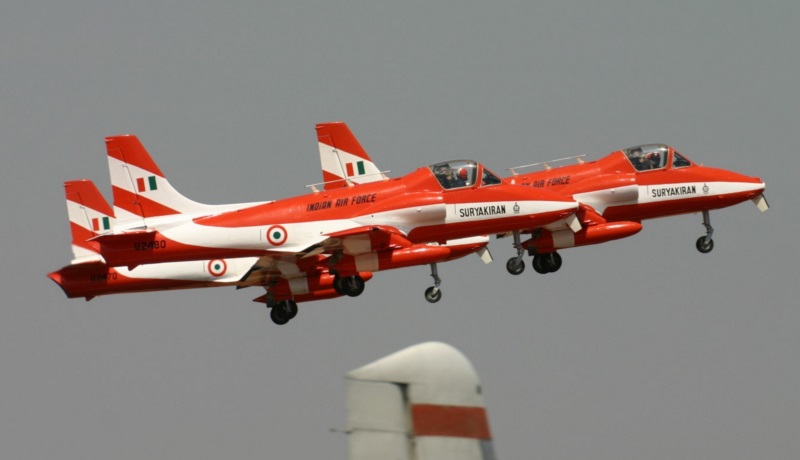
A "Kiran Mark II" was then developed, with a Bristol Siddely Orpheus engine providing a maximum thrust of 19 kN (1,905 kgp / 4,200 lbf). It also had twin 7.62-millimeter machine guns in the nose, and four underwing stores hardpoints. Initial flight was on 30 July 1976, with service deliveries from 1985. 61 were built to end of Kiran production in 1989.
The Kiran has been generally replaced by the BAE Hawk jet trainer, built under license by HAL. Both the IAF and the Indian Navy flew aerobatic display teams using the Kiran, the teams being named Surya Kiran and Surya Pawan respectively. In 2018, six Kirans were donated by India to neighboring Myanmar, the gesture being seen an effort to counterbalance Chinese influence in Myanmar.
BACK_TO_TOP* Sources for this document included various aviation encyclopedias, the online Wikipedia, and my collection of JANE'S ALL THE WORLD'S AIRCRAFT. These machines are not over-documented.
* Illustrations credits:
* Revision history:
v1.0.0 / 01 sep 21 v1.0.1 / 01 aug 23 / Review & polish. (*)BACK_TO_TOP
